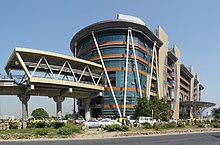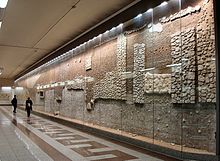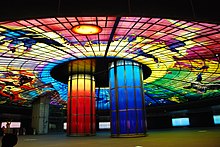Metro station

An entrance to Consolação Station on Paulista Avenue in São Paulo, Brazil

HUDA City Centre Metro Station is a terminal station in Gurugram, India that provides parking and disability facilities and is located near multiple colleges and universities.

Platform of Dortmund Stadthaus station in Dortmund, Germany

Every station of the Paris Métro Line 14 in France has automatic platform screen doors

Display of archeological relics found during construction in Athens Metro, part of the Syntagma Metro Station Archaeological Collection

Glass art in Formosa Boulevard Station in Kaohsiung, Taiwan

Titan Subway Station, Bucharest, Romania
A metro station or subway station is a railway station for a rapid transit system, which as a whole is usually called a "metro" or "subway". A station provides a means for passengers to purchase tickets, board trains, and evacuate the system in the case of an emergency.
Contents
1 Location
2 Facilities
3 Transfer stations
4 Platform-edge doors
5 Architectural design
6 Records
7 See also
8 References
9 External links
Location
The location of a metro station is carefully planned to provide easy access to important urban facilities such as roads, commercial centres, major buildings and other transport nodes.
Most stations are located underground, with entrances/exits leading up to ground or street level. The bulk of the station is typically positioned under land reserved for public thoroughfares or parks. Placing the station underground reduces the outside area occupied by the station, allowing vehicles and pedestrians to continue using the ground-level area in a similar way as before the station's construction. This is especially important where the station is serving high-density urban precincts, where ground-level spaces are already heavily utilised.[1]
In other cases, a station may be elevated above a road, or at ground level depending on the level of the train tracks. The physical, visual and economic impact of the station and its operations will be greater. Planners will often take metro lines or parts of lines at or above ground where urban density decreases, extending the system further for less cost. Metros are most commonly used in urban cities, with great populations.[2] Alternatively, a preexisting railway land corridor is re-purposed for rapid transit.[3]
Facilities
At street level the logo of the metro company marks the entrances/exits of the station. Usually, signage shows the name of the station and describes the facilities of the station and the system it serves. Often there are several entrances for one station, saving pedestrians from needing to cross a street and reducing crowding.[1]
A metro station typically provides ticket vending and ticket validating systems. The station is divided into an unpaid zone connected to the street, and a paid zone connected to the train platforms. The ticket barrier allows passengers with valid tickets to pass between these zones. The barrier may operated by staff or more typically with automated turnstiles or gates that open when a transit pass is scanned or detected.[4] Some small metro systems dispense with paid zones and validate tickets with staff in the train carriages.[5]
Access from the street to ticketing and the train platform is provided by stairs, concourses, escalators, elevators and tunnels. The station will be designed to minimise overcrowding and improve flow, sometimes by designating tunnels as one way.[2] Permanent or temporary barriers may be used to manage crowds. Some metro stations have direct connections to important nearby buildings (see underground city).
Most jurisdictions mandate that people with disabilities must have unassisted use of the station. This is resolved with elevators, taking a number of people from street level to the unpaid ticketing area, and then from the paid area to the platform. In addition, there will be stringent requirements for emergencies, with backup lighting, emergency exits and alarm systems installed and maintained. Stations are a critical part of the evacuation route for passengers escaping from a disabled or troubled train.[6]
A subway station may provide additional facilities, such as toilets, kiosks and amenities for staff and security services, such as Transit police.
Transfer stations
Some metro stations are interchanges, serving to transfer passengers between lines or transport systems. The platforms may be multi-level. Transfer stations handle more passengers than regular stations, with additional connecting tunnels and larger concourses to reduce walking times and manage crowd flows.
Platform-edge doors
In some stations, especially where trains are fully automated, the entire platform is screened from the track by a wall, typically of glass, with automatic platform-edge doors (PEDs). These open, like elevator doors, only when a train is stopped, and thus eliminate the hazard that a passenger will accidentally fall (or deliberately jump) onto the tracks and be run over or electrocuted.
Control over ventilation of the platform is also improved, allowing it to be heated or cooled without having to do the same for the tunnels. The doors add cost and complexity to the system, and trains may have to approach the station more slowly so they can stop in accurate alignment with them.
Architectural design
Metro stations, more so than railway and bus stations, often have a characteristic artistic design that can identify each stop. Some have sculptures or frescoes. For example, London's Baker Street station is adorned with tiles depicting Sherlock Holmes. The tunnel for Paris' Concorde station is decorated with tiles spelling the Déclaration des Droits de l'Homme et du Citoyen. Every metro station in Valencia, Spain has a different sculpture on the ticket-hall level. Alameda station is decorated with fragments of white tile, like the dominant style of the Ciutat de les Arts i les Ciències. Each of the original four stations on Line 8 of the Beijing Subway is decorated traditionally with elements of Chinese culture. On the Tyne and Wear Metro, the station at Newcastle United's home ground St James' Park is decorated in the clubs famous black and white stripes. Each station of the Red Line and Purple Line subway in Los Angeles was built with different artwork and decorating schemes, such as murals, tile artwork and sculptural benches. Every station of the Mexico City Metro is prominently identified by a unique icon in addition to its name, because the city had high illiteracy rates at the time the system was designed.
Some metro systems, such as those of Naples, Stockholm, Moscow, St. Petersburg, Tashkent, Kiev,[7]Montreal, Lisbon, Kaohsiung and Prague are famous for their beautiful architecture and public art. The Paris Métro is famous for its art nouveau station entrances; while the Athens Metro is known for its display of archeological relics found during construction.
However, it is not always the case that metro designers strive to make all stations artistically unique. Sir Norman Foster's new system in Bilbao, Spain uses the same modern architecture at every station to make navigation easier for the passenger, though some may argue that this is at the expense of character.
Metro stations usually feature prominent poster and video advertising, especially at locations where people are waiting, producing an alternative revenue stream for the operator.[8]
Records
The largest and most complex metro station in the world is the Paris Métro-RER station Châtelet-Les Halles in France.[9]
The metro station with the highest elevation above ground in the world is New York City's Smith–Ninth Streets station of the New York City Subway in the United States.[10]
The deepest metro station in the world is the Arsenalna station located in Kiev, it is located at 105.5 m below the ground.
The northernmost metro station in the world is Mellunmäki metro station of the Helsinki metro in Finland, and the southernmost underground station in the world is Parliament railway station in Melbourne.[11]
See also
- Bus stop
- Deep column station
In a Station of the Metro (poem)- List of metro systems
- Outline of transport
- Pylon station
- Railway platform
- Rapid transit
- Shallow column station
- Single-vault station
References
^ ab Tumlin, Jeffrey (2012). Sustainable Transportation Planning: Tools for Creating Vibrant, Healthy, and Resilient Communities. Wiley. p. 118..mw-parser-output cite.citationfont-style:inherit.mw-parser-output .citation qquotes:"""""""'""'".mw-parser-output .citation .cs1-lock-free abackground:url("//upload.wikimedia.org/wikipedia/commons/thumb/6/65/Lock-green.svg/9px-Lock-green.svg.png")no-repeat;background-position:right .1em center.mw-parser-output .citation .cs1-lock-limited a,.mw-parser-output .citation .cs1-lock-registration abackground:url("//upload.wikimedia.org/wikipedia/commons/thumb/d/d6/Lock-gray-alt-2.svg/9px-Lock-gray-alt-2.svg.png")no-repeat;background-position:right .1em center.mw-parser-output .citation .cs1-lock-subscription abackground:url("//upload.wikimedia.org/wikipedia/commons/thumb/a/aa/Lock-red-alt-2.svg/9px-Lock-red-alt-2.svg.png")no-repeat;background-position:right .1em center.mw-parser-output .cs1-subscription,.mw-parser-output .cs1-registrationcolor:#555.mw-parser-output .cs1-subscription span,.mw-parser-output .cs1-registration spanborder-bottom:1px dotted;cursor:help.mw-parser-output .cs1-ws-icon abackground:url("//upload.wikimedia.org/wikipedia/commons/thumb/4/4c/Wikisource-logo.svg/12px-Wikisource-logo.svg.png")no-repeat;background-position:right .1em center.mw-parser-output code.cs1-codecolor:inherit;background:inherit;border:inherit;padding:inherit.mw-parser-output .cs1-hidden-errordisplay:none;font-size:100%.mw-parser-output .cs1-visible-errorfont-size:100%.mw-parser-output .cs1-maintdisplay:none;color:#33aa33;margin-left:0.3em.mw-parser-output .cs1-subscription,.mw-parser-output .cs1-registration,.mw-parser-output .cs1-formatfont-size:95%.mw-parser-output .cs1-kern-left,.mw-parser-output .cs1-kern-wl-leftpadding-left:0.2em.mw-parser-output .cs1-kern-right,.mw-parser-output .cs1-kern-wl-rightpadding-right:0.2em
^ ab Edwards, Jack (1990). Civil Engineering for Underground Rail Transport. Butterworth & Co.
^ "Landmarks in urban transport". Nexus. 2015. Archived from the original on 2016-03-24. Retrieved 2016-05-15.
^ Benz, G.; et al. (1987). Rapid-rail transit and planning tools. National Research Council, Washington DC, Transportation Research Board.
^ "Midland Metro Cash Fares". National Express. 2016. Archived from the original on 2016-05-26. Retrieved 2016-05-15.
^ Xiaohui Xu; Bo Song; Chunxia Li; Xujun Hu (2010). "Study on the Safety and Disaster-Prevention Signing System of the Subway Based on Site Investigation at Home and Abroad" (PDF). University of Science and Technology Beijing, China. Archived (PDF) from the original on 2016-06-09. Retrieved 2016-05-15.
^ "Metro Arts and Architecture". Metro Bits. Archived from the original on 2006-12-02. Retrieved 2006-12-04.
^ "Subway Advertising". Archived from the original on 2016-05-03. Retrieved 2016-05-16.
^ "Archived copy" (PDF). Archived from the original (PDF) on 2008-03-07. Retrieved 2008-03-13.CS1 maint: Archived copy as title (link)
^ "MTA News - MTA". www.mta.info. Archived from the original on 25 September 2012. Retrieved 28 April 2018.
^ "Mellunmäki The world's northernmost metro station, in Helsinki - thisisFINLAND". finland.fi. Archived from the original on 28 April 2018. Retrieved 28 April 2018.
External links
UrbanRail.Net — descriptions of all metro systems in the world, each with a schematic map showing all stations.
